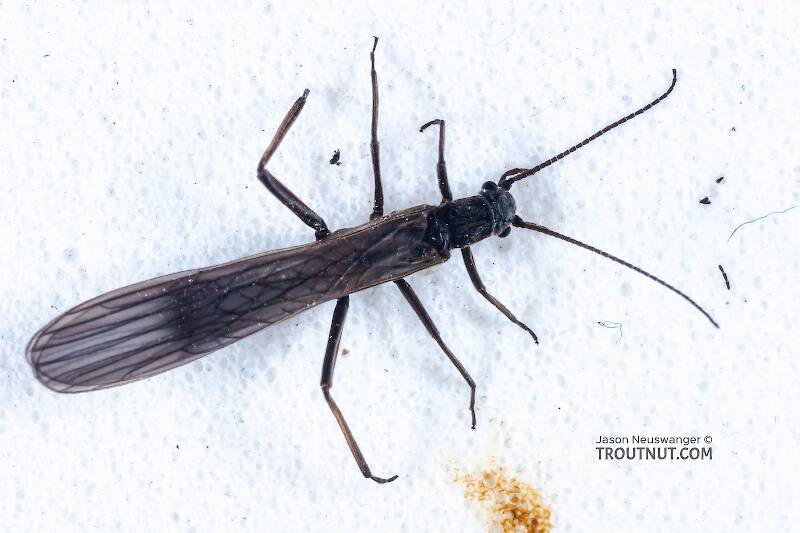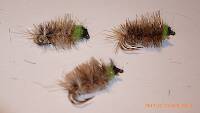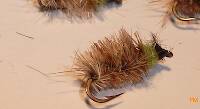
Blue-winged Olives
Baetis
Tiny Baetis mayflies are perhaps the most commonly encountered and imitated by anglers on all American trout streams due to their great abundance, widespread distribution, and trout-friendly emergence habits.
Featured on the forum

This dun emerged from a mature nymph on my desk. Unfortunately its wings didn't perfectly dry out.

Troutnut is a project started in 2003 by salmonid ecologist Jason "Troutnut" Neuswanger to help anglers and
fly tyers unabashedly embrace the entomological side of the sport. Learn more about Troutnut or
support the project for an enhanced experience here.
DarkDun
Posts: 16
Posts: 16
DarkDun on Jan 9, 2007January 9th, 2007, 3:25 pm EST
What is body color? Are these likely to occurr in the Appallacians?
Troutnut on Jan 9, 2007January 9th, 2007, 3:34 pm EST
Very very dark brown and black. And yes, it's likely you'll find these in Appalachia.
Jason Neuswanger, Ph.D.
Troutnut and salmonid ecologist
Troutnut and salmonid ecologist
Martinlf on Jan 9, 2007January 9th, 2007, 11:49 pm EST
Jason, was dark dun possibly asking a geographical rather than taxonomic question? (The word "these" led me to wonder this.) If so, would the answer be no?
"He spread them a yard and a half. 'And every one that got away is this big.'"
--Fred Chappell
--Fred Chappell
Taxon on Jan 10, 2007January 10th, 2007, 5:33 am EST
Louis-
I'm normally able to understand your meaning, but you've really left me in the wake this time. I only saw a question about color of body, and a question about distribution. What taxonomic question did Dark Dun ask?
I'm normally able to understand your meaning, but you've really left me in the wake this time. I only saw a question about color of body, and a question about distribution. What taxonomic question did Dark Dun ask?
Troutnut on Jan 10, 2007January 10th, 2007, 6:43 am EST
I'm confused too.
Jason Neuswanger, Ph.D.
Troutnut and salmonid ecologist
Troutnut and salmonid ecologist
Martinlf on Jan 10, 2007January 10th, 2007, 9:10 am EST
OK, I see that dashing in and out of the site too early the other morning with little time to spare before making my daughter late for school, I hurriedly misread Jason's original reply. Let me explain how, as best I can, though you'll probably suspect crystal meth before I finish.
Somehow I was thinking that Jason's reply to DarkDunn's second question, "Are these [bugs] likely to occur in the Appalachian [region]s?" meant: "you'll find these [typical colors] in Appalachia [a mythical stonefly genus I thought I remembered from the original photo--funny, huh?]."
(Might the range of color within a genus almost be a kind of taxonomic issue, Roger?--OK, I guess not. But this is how my obviously-not-fully-awake mind was working.)
Now I clearly see that Jason was answering the distribution question when he said, "yes, it's likely you'll find these [bugs] in Appalachia [the region]."
So, Jason, Roger, I not only confused myself, but you too in the process, and I'm feeling rather silly. This calls for a bit of Latin:
Mea culpa.
Somehow I was thinking that Jason's reply to DarkDunn's second question, "Are these [bugs] likely to occur in the Appalachian [region]s?" meant: "you'll find these [typical colors] in Appalachia [a mythical stonefly genus I thought I remembered from the original photo--funny, huh?]."
(Might the range of color within a genus almost be a kind of taxonomic issue, Roger?--OK, I guess not. But this is how my obviously-not-fully-awake mind was working.)
Now I clearly see that Jason was answering the distribution question when he said, "yes, it's likely you'll find these [bugs] in Appalachia [the region]."
So, Jason, Roger, I not only confused myself, but you too in the process, and I'm feeling rather silly. This calls for a bit of Latin:
Mea culpa.
"He spread them a yard and a half. 'And every one that got away is this big.'"
--Fred Chappell
--Fred Chappell
Taxon on Jan 10, 2007January 10th, 2007, 9:39 am EST
Louis-
Planto voluntas.
Planto voluntas.
Troutnut on Jan 10, 2007January 10th, 2007, 11:10 am EST
Funny, I had actually thought of that -- confusing Appalachia for a genus -- and discounted it as too improbable. Then again, it is more likely than the hallucinogenic alternatives!
Jason Neuswanger, Ph.D.
Troutnut and salmonid ecologist
Troutnut and salmonid ecologist
Martinlf on Jan 10, 2007January 10th, 2007, 11:20 am EST
Roger,
Gratia tibi; nemo nisi per amicitiam cognoscitur.
Jason,
Once you get to know me, you'll find almost anything is possible. ;>
Gratia tibi; nemo nisi per amicitiam cognoscitur.
Jason,
Once you get to know me, you'll find almost anything is possible. ;>
"He spread them a yard and a half. 'And every one that got away is this big.'"
--Fred Chappell
--Fred Chappell
Softhackle on Jan 10, 2007January 10th, 2007, 12:28 pm EST
Geesh,
You guys must be reading my mind. I was thinking about these stoneflies today and wondering how early they'll be showing up this year. Last year was the first year I actually took trout on these on my home river. I guess it was because the river was low for the early part of the year, and the trout were actually seeing them. Usually, it's high, fast and muddy when these flies are about. I actually took fish on a soft-hackle I made up fished in the surface film or just below.
Mark
You guys must be reading my mind. I was thinking about these stoneflies today and wondering how early they'll be showing up this year. Last year was the first year I actually took trout on these on my home river. I guess it was because the river was low for the early part of the year, and the trout were actually seeing them. Usually, it's high, fast and muddy when these flies are about. I actually took fish on a soft-hackle I made up fished in the surface film or just below.
Mark
"I have the highest respect for the skilled wet-fly fisherman, as he has mastered an art of very great difficulty." Edward R. Hewitt
Flymphs, Soft-hackles and Spiders: http://www.troutnut.com/libstudio/FS&S/index.html
Flymphs, Soft-hackles and Spiders: http://www.troutnut.com/libstudio/FS&S/index.html
Taxon on Jan 10, 2007January 10th, 2007, 12:45 pm EST
Louis-
Ego trado.
Ego trado.
Martinlf on Jan 10, 2007January 10th, 2007, 1:08 pm EST
Roger,
Great reply, given the multiple definitions of the verb. It's back to English for me too--with my Collin's Gem and Bradly's Arnold on the shelf in the office, Latin's too much work.
Softhackle,
I took a look at your flies on the website you mentioned, and your bio. It's neat to get to know someone from the forum a bit more. Would you share your Capniidae stonefly soft hackle pattern with us?
Great reply, given the multiple definitions of the verb. It's back to English for me too--with my Collin's Gem and Bradly's Arnold on the shelf in the office, Latin's too much work.
Softhackle,
I took a look at your flies on the website you mentioned, and your bio. It's neat to get to know someone from the forum a bit more. Would you share your Capniidae stonefly soft hackle pattern with us?
"He spread them a yard and a half. 'And every one that got away is this big.'"
--Fred Chappell
--Fred Chappell
Softhackle on Jan 11, 2007January 11th, 2007, 2:06 am EST
Louis,
Copy and paste this link into your browser address window:
http://i12.photobucket.com/albums/a222/Soft-hackle/Bl.jpg
The fly has not yet been posted to my site, but will be added, soon. So you get first "look" at it.
The fly is fairly simple, yet it worked very well for these flies. What was nice about it was the fact it could be fished wet, downstream, or upstream in surface, or just below. I even fished it slightly down and across in the surface to feeding fish.
To me there is nothing like a flymph or softhackle to get fish moving. The movement of the hackle is the key.
Here is the recipe:
Black Stone Flymph--
Hook: For wet version-Standard wet fly longer shank hook. For fishing in the film or just under use a fine wire, long shank dry fly hook as shown-size 12-14-16.
Thread: Black
Hackle: I used two crow hackles, one wound through the thorax, the other was wrapped at the head as a collar( Use only one turn as a collar.). Strip one side of the fibers off each hackle or there'll be too much hackle. (I'm sure black hen hackle could be substituted for crow.)
Ribbing: a fine piece of black Krystal Flash through the abdomen.
Abdomen: Black rabbit, spun Leisenring style on black thread.
Throrax: Dubbed heavier than the abdomen to the tying thread.
Hope this helps and encourages others to try it.
Mark
Copy and paste this link into your browser address window:
http://i12.photobucket.com/albums/a222/Soft-hackle/Bl.jpg
The fly has not yet been posted to my site, but will be added, soon. So you get first "look" at it.
The fly is fairly simple, yet it worked very well for these flies. What was nice about it was the fact it could be fished wet, downstream, or upstream in surface, or just below. I even fished it slightly down and across in the surface to feeding fish.
To me there is nothing like a flymph or softhackle to get fish moving. The movement of the hackle is the key.
Here is the recipe:
Black Stone Flymph--
Hook: For wet version-Standard wet fly longer shank hook. For fishing in the film or just under use a fine wire, long shank dry fly hook as shown-size 12-14-16.
Thread: Black
Hackle: I used two crow hackles, one wound through the thorax, the other was wrapped at the head as a collar( Use only one turn as a collar.). Strip one side of the fibers off each hackle or there'll be too much hackle. (I'm sure black hen hackle could be substituted for crow.)
Ribbing: a fine piece of black Krystal Flash through the abdomen.
Abdomen: Black rabbit, spun Leisenring style on black thread.
Throrax: Dubbed heavier than the abdomen to the tying thread.
Hope this helps and encourages others to try it.
Mark
"I have the highest respect for the skilled wet-fly fisherman, as he has mastered an art of very great difficulty." Edward R. Hewitt
Flymphs, Soft-hackles and Spiders: http://www.troutnut.com/libstudio/FS&S/index.html
Flymphs, Soft-hackles and Spiders: http://www.troutnut.com/libstudio/FS&S/index.html
Quick Reply
Related Discussions
Topic
Replies
Last Reply
0
Jul 2, 2012
by Bjorntofish
by Bjorntofish








